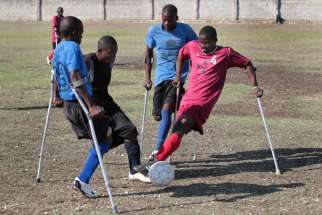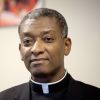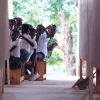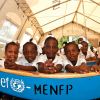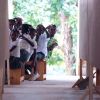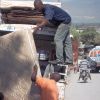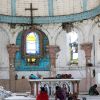WASHINGTON - Cardinal Chibly Langlois of Les Cayes, Haiti, charged that police have failed to protect religious and priests who have faced a growing number of break-ins, robberies and attacks, including rape.
Pope thanks Catholics for helping Haiti, says much more left to do
VATICAN CITY - Pope Francis thanked Catholics worldwide for helping people in Haiti recover from a devastating earthquake, but said "there is still much work left to do."
Migrants in a ‘perpetual Good Friday’
TORONTO - On the sugar cane plantations in the Dominican Republic, life is bitter for the Haitian migrants who farm the land.
WASHINGTON - Knowing that American Catholics stand in solidarity with the Haitian Catholic Church opens new opportunities for people of both countries to learn from each other and begin to shape a unified future together, a group of Haitian bishops said.
In Washington for the One Table, Many Partners National Solidarity Conference June 1-3, the prelates said during a visit to the U.S. Conference of Catholic Bishops they see U.S.-Haiti solidarity strengthening, leading to a more self-sufficient Haitian church as long as there is a mutual exchange of ideas.
SANTO DOMINGO, Dominican Republic - Haitian and Dominican bishops said they will create a commission that will work to help reconstruct Haiti more than two years after a major earthquake destroyed the Caribbean nation.
Several Catholic groups have been working on the ground toward reconstructing the country. The commission will differ in that it will focus on recruiting volunteers and encouraging donations from the private sector.
New LifeSite accusations target D&P Haitian partner APROSIFA
Canadian bishops are once again facing embarrassing questions about an overseas organization that received funding from the Canadian Catholic Organization for Development and Peace (D&P).
This time, the issue involves a Haitian organization, APROSIFA, that allegedly dispenses free contraceptives and promotes access to abortion, according to an online report.
Betting on Haiti’s next generation
There are several revolutions going on in post-earthquake Haiti and one of them is changing how Canada’s Catholic development agency thinks about its work.
Prior to the January 2010 earthquake, the Canadian Catholic Organization for Development and Peace’s core development work had always been long-term. Agreements with partner agencies usually spanning four or five years, with some partner relationships that have extended over 20 years.
Now the problems in Haiti have Development and Peace thinking in terms of generations.
D&P's Share Lent appeal launches
OTTAWA - Archbishop Richard Smith is inviting Catholics to open their hearts to those in need by contributing generously to this year’s Share Lent campaign.
The annual fundraising campaign kicks off Feb. 22 and runs through April 7. It is the major fundraiser for the Canadian Catholic Organization for Development and Peace, the Canadian bishops’ development agency, accounting for about 30 per cent of its annual budget.
WASHINGTON - It took almost two years, but Haitian earthquake survivor Sonya Mallebranche has a place she can call home again.
It's only three rooms, making it less than perfect, Mallebranche admits, especially for four adults and three toddler grandchildren. But Mallebranche, 51, finds it far better than living in a tattered tent in the fetid, dusty camp known as Petite Place Cazeau alongside hundreds of others displaced by the powerful Jan. 12, 2010, earthquake that leveled much of the region around Port-au-Prince.
Catholics have made a difference in Haiti
OTTAWA - After a solidarity mission to Haiti Dec. 15-21, Archbishop Richard Smith came away with a deep appreciation of the work Canadian Catholics are funding to help the poor through a range of Caritas partners.
“What I saw there was the Gospel in action, lives being changed,” said the Canadian Conference of Catholic Bishops (CCCB) president.
Smith also came away struck with the need for a long-term commitment to help renew the country devastated by a catastrophic earthquake two years ago.
CCCB delegation makes solidarity mission to Haiti
OTTAWA - As the second anniversary of Haiti’s catastrophic earthquake approaches, a Canadian Conference of Catholic Bishops delegation is visiting the country on a solidarity mission Dec. 14-21.
The Jan. 12, 2010 earthquake killed more than 220,000 people, seriously injured more than 300,000 and devastated large sections of Port-au-Prince, Jacmel, Léogâne and other areas. Three million people were left homeless or otherwise seriously affected.
Haitians must look to themselves to rebuild their nation
![]()
As Haitians go about constructing their future they have some surprising resources to draw upon. These include the Church, the international community and the vast network of humanitarian NGOs around the world.
But one of most overlooked accounts is the community of extraordinarily talented expatriate Haitians, mainly in Canada, France and the United States, who are deeply attached to the land of their birth.
The Catholic Register spoke to Haitian Studies Association president Guerda Nicolas about Haiti's present and future reality. Nicolas has been deeply involved in rebuilding efforts in Petit Goave near Port-au-Prince and has been called upon to advise the Haitian government. A professor of psychology at the University of Miami, she has both an insider's perspective and the ability to see Haiti through the world's eyes.
Catholic Register: What is your sense about the present state of the recovery effort?
Guerda Nicolas: I usually try to make it back to Haiti five to six times a year, but I've been going monthly since the quake. I don't think recovery is taking place yet. I participate in a lot of planning. I'm on the committee for higher education. I'm on a committee with the assistant minister of health. There's a lot of talk and discussion and strategies, but I haven't really seen a lot of movement.
I was really pleased when I was in Haiti recently that people have stopped waiting, especially outside of Port-au-Prince. I think the situation is quite different outside of Port-au-Prince. People have already started to take action into their own hands and say, "We really need to rebuild our home and rebuild our area. We can't afford to wait for aid." I think that's a better strategy.
CR: Was the earthquake an opportunity to start again for a nation that has been badly governed for so much of its history?
GN: Haiti has always been a very vulnerable place. There are lots of people who have in interest in Haiti and not necessarily for Haiti.
People are very cautious about this idea of rebuilding and refounding Haiti. People in Haiti — including myself who was born, grew up and did most of my education in Haiti — we are just concerned about the plans.
CR: Are you hopeful?
GN: I am very hopeful that the Haitian people are very, very strong and very, very resilient. People get a very narrow perspective of who Haitians are and what the Haitian people are about. Most people get a glimpse of what Haiti is about from a Port-au-Prince perspective, and for me that's like getting a picture of what Canada is like from a Toronto perspective or getting a glimpse of the U.S. from New York. It doesn't really capture the essence of what I think Haiti is about.
When I'm outside of Port-au-Prince I'm very hopeful. When I'm in Port-au-Prince I can't help but be depressed.
CR: How does the Haitian religious sense determine psychological treatment of people traumatized by the last year?
GN: The resiliency aspect of Haitians is because they are faith-based people. We're talking about people who have a really strong faith that doesn't get rattled by disasters, even what we just saw.
The majority of people in Haiti believe in God, in God's purpose, and in their purpose in this world. And they use that. That is really what people use to deal with the uncertainty of life. It helps them to cope with whatever's coming their way.
Mostly people are just praying. They're praying and going to church, not just on Sunday but all the time. That's their number one coping mechanism. It's a really strong belief that God is with them, and is always with them, and God is good and is good all the time. When things happen that you don't understand you should have even stronger faith.
CR: Haitians also believe in the devil, and many people after the earthquake experienced nightmares featuring the devil. Can you explain the devil in the Haitian mindset?
GN: That's a part of our Catholic upbringing. I remember growing up and going to Catholic school, and there were really only two types of doctrine. One was God and the goodness of God and the other was the devil. All bad things are not a result of God. It's got to be a result of the other.
There's a sense from people that this (earthquake, cholera, hurricanes) is not God's doing. It can't be because God is just too good. Therefore it is the work of the devil. It is the work of evilness. This (earthquake) is not an opportunity to be unfaithful to our God because that's not what our God would do. That is the message that is not forgotten.
When I see the parents talking to the kids and the kids are wondering, especially the adolescents are wondering, "why are you going to church and why are you praying? Why would God do such a thing? Why would God allow such a thing to happen to us?" The answer is really simple. This is not the work of God. This is the work of the other. And we're going to have to continue to praise Him for His glory and what He did, which He did for us. Because that's the only way we will defeat the devil. This is not the time for us to become non-believers. That's the message they're giving to their kids.
CR: Does Haiti have the resources to deal with a traumatized population?
GN: Haiti has more of the resources that it needs than people have assumed. I think people assume that there are no psychiatric nurses in Haiti, that there are no social workers, that there are no psychologists and that there are no psychiatrists in Haiti. And that's false.
CR: What role do you see for Haitian expatriates? Can Haiti use you, use that community around the world, to build a new future?
GN: Actually, I think Haiti is dependent on that. My message this year to the Haitian Studies Association was very clear. We have Haitian scholars in every discipline that Haiti is in need of. We have medical doctors, we have psychiatrists, psycghologists, we have educators, we have nurses, we have engineers. We have all the groups... Haiti is in need of us now.
We're in a position that is very different from somebody who is not familiar with the culture, who is not familiar with the soil of Haiti.
It's very clear to me that Haiti's future is not dependent on foreign aid and foreigners coming into Haiti. That has been the history of Haiti in the past. I really do believe that this is the time that we need to come back home. It is time for Haitians to come back home. Not on a permanent level. I"m not asking everybody to go as often as I do, or to go back and live in Haiti. But those talented minds are needed in Haiti. People need to see people who speak for them who are highly educated. That's the kind of role models this next generation needs to see.
CR: Do we foreigners have a part to play?
GN: Absolutely. Working with some of my colleagues and some of the work we're doing there's an opportunituy to enrich both ways. My colleagues who are white get a chance to be enriched and be exposed to a whole other culture and a way of life that is very different.
I am in need of that collaboration with my colleagues. I can only speak from my experience, working with some of my white colleagues, how crucial it is to have their expertise, their level of experience and their outside perspectives in what we are doing.
I'm so in it, that once in a while it's good to have somebody say, "Hey Guerda have you thought about this?" I don't have all the answers. And it's really really good to be part of a team. For me that's the answer, to be part of a teamwork approach.
CR: Is the Church a help or hindrance in Haiti's recovery?
GN: If you really want to get Haitians moving there are only two things you have to say to them. One is the Church. It's really having an opportunity to connect with their priests and pastors, to hear from their priests and pastors. That has a lot of meaning to them. The second is to talk to them about how to get an education for their kids.
If we don't have a Church component in Haiti, really, honesty there's only half a Haiti. Haiti is so dependent, so attached, and the people of Haiti are so ingrained in their Church, in the Church message and in their spiritual self that it is absolutely crucial that that continues. But I think an examination of how the message is delivered is really important.
The question is not the importance of the Church, but really what kind of message is the Church delivering, and how is that message consistent on a day-to-day, week-to-week and monthly basis?
- RAISING UP HAITI -
a Catholic Register special report
Haiti's churches need healing [slideshow]
What now in Haiti?
Post-traumatic stress proves difficult
Catholic aid organizations fly under the radar
Canadian engineer to oversee Haiti’s Church rebuild
Haiti must take this opportunity to change
Crisis makes D&P rethink how it operates
Bold education plan held up by a lack of funds
Church holds community together
D&P-funded program provides pro-life solution to Haiti's sexual violence
Haitians must look to themselves to rebuild their nation

In the tent camps around Port-au-Prince, in the collapsed and desperate slums of Cite Soleil, amid the violence of a chaotic city policed by United Nations troops from around the world there’s a pro-life story.
Kay Famn (Creole for the House of Women) doesn’t call itself a pro-life organization. The Development and Peace partner proudly claims the title feminist. What Kay Famn does, however, lifts up women and the value of life in the face of violence and the most corrosive poverty in the Western Hemisphere.
Before the earthquake Kay Famn ran one of the only women’s shelters in Haiti — a country where until 2005 rape was considered a crime against honour rather than a crime against a person. Now with more than one million people crammed into tent camps where there are no locked doors and the shadows at night hide all kinds of crime, Kay Famn is seeing a steady stream of girls, many between 13 and 15, come to them pregnant.
“They arrive pregnant and give birth here,” Kay Famn co-ordinator Yolette Jeanty told The Catholic Register.
Somebody has to prepare the girls for motherhood.
“They’re kids we are preparing to give birth,” said Jeanty. “They don’t have families. They stay with other kids.”
The program is called Revive. In addition to dealing with the trauma of the girls’ situation — whether they’ve been raped, seduced by an older man or surprised to discover they are pregnant — Kay Famn tries to keep the girls in school or at least provide basic literacy and job training.
If not for Kay Famn, no end of illegal and dangerous abortions are performed in Haiti. Given the state of health care, the girls chances of surviving child birth without Kay Famn are low. Even before the earthquake, the maternal mortality ratio for Haiti was 670 for every 100,000 live births, according to Unicef.
The problem is bigger than Kay Famn can deal with. They’ve got room for about a dozen girls at a time. They can offer financial support for 40 girls. Out there in the camps there’s an epidemic of sexual violence and a kind of brutal economy in which sex is traded for protection, food and shelter.
All of that means there’s good reason to help Kay Famn with financing and strategy, said Development and Peace executive director Michael Casey.
“You look at that tragedy, that kind of thing happening to very young girls, the violence being perpetrated against women in the camps — the stuff that Kay Famn is working with,” he said.
“Those are very, very important stories.”
“There’s a lot of sexual violence against little girls and adolescents,” said Jeanty. “Men are using violence to bring girls to bed. Or trading rice for sex.”
Kay Famn does not advocate for abortion access because that won’t solve Haiti’s problem with sexual violence and predation. They do what they can for the girls who come to them.
“The situation in the camps has exacerbated the problem,” said Jeanty.
- RAISING UP HAITI -
a Catholic Register special report
Haiti's churches need healing [slideshow]
What now in Haiti?
Post-traumatic stress proves difficult
Catholic aid organizations fly under the radar
Canadian engineer to oversee Haiti’s Church rebuild
Haiti must take this opportunity to change
Crisis makes D&P rethink how it operates
Bold education plan held up by a lack of funds
Church holds community together
D&P-funded program provides pro-life solution to Haiti's sexual violence
Haitians must look to themselves to rebuild their nation
Church holds community together

Madame Odessi Petit Foin knows exactly what she’s missing since the church in Duvale collapsed, along with her house and most of the other houses in the farming community.
Duvale always did need lots of things. It was never rich. It needed a new road before the earthquake and now it needs it more. It has needed a new school for a long time and thanks to the earthquake it got one — built with aid money on the foundations of the collapsed church. And it needs houses for the families still living in tents by their tiny plots of tomatoes, cucumbers and peas.
In Petit Foin’s opinion, Duvale also needs its church.
“It preaches morality and conversion,” she said.
She also makes the point that it’s through the church that Duvale gets access to the international aid money which will finance a new Caritas Port-au-Prince agricultural improvement project. But that’s not the most important reason that Duvale needs its church.
“The church in Duvale plays a very big role that holds together friends and family,” she said.
Petit Foin is not an economist, a politician, a theologian or philosopher. But as she stands in the old church hall, which has become the church in Duvale, she’s hit upon something quite important.
There’s more to infrastructure than the efficient delivery of goods to market on safe, smooth and broad roads. A community requires infrastructure so it can hold together, so it can know itself and meet the world. Duvale needs its church so that it can be a community which people recognize when they see the church.
The people of Duvale themselves need to recognize that they are a community of families when they meet for Sunday morning Mass.
There is such a thing as spiritual infrastructure. In fact, if Duvale had a great road connecting it with Port-au-Prince but its people had lost their way and no longer knew themselves, no longer cared for each other, no longer lived in and for their families — well, that would be a road to nowhere.
- RAISING UP HAITI -
a Catholic Register special report
Haiti's churches need healing [slideshow]
What now in Haiti?
Post-traumatic stress proves difficult
Catholic aid organizations fly under the radar
Canadian engineer to oversee Haiti’s Church rebuild
Haiti must take this opportunity to change
Crisis makes D&P rethink how it operates
Bold education plan held up by a lack of funds
Church holds community together
D&P-funded program provides pro-life solution to Haiti's sexual violence
Haitians must look to themselves to rebuild their nation
Bold education plan held up by a lack of funds

For the first time in St. Antoine’s history the teachers are worried about their girls in Grade 6. Before the Jan. 12, 2010 earthquake 100 per cent of Pupils de St. Antoine students would pass state exams that qualify them to move on to Grade 7 and secondary school.
This year most of the girls are living in tents on the Champ de Mars. Before the earthquake there were 700 students, now there are 570. Many of the parents are having trouble coming up with $180 for school fees, to say nothing of books and uniforms. Development and Peace is helping by paying for hearty lunches of rice and beans with vegetables and meat. The girls are eating better than their parents.
The girls’ biggest handicap is the loss of their school building, according to school principal Sr. Sainte-Anne Jean-Baptiste. The old St. Antoine’s is a heap of rubble and the Sisters of St. Anne have no money to clear it and rebuild or to buy another site.
“The education we want to give children we can’t give right now. They need to progress — to go from one success to another,” said Jean-Baptiste. “It’s almost impossible to study in the tents.”
St. Antoine’s is borrowing the classrooms of Cole Marie Reine Immaculate. When that school lets out in the afternoon, St. Antoine’s moves in. But St. Antoine’s has no offices, no meeting rooms, no equipment, nothing but the classrooms — many of which are squares on the concrete courtyard walled off by sheets of plywood beneath a tin roof.
There are about 40 girls in every classroom. Their teachers also live in tents, though many are able to remain at the site of their old homes and thus are spared the crowded, fetid, cholera-breeding tent camps.
Veteran teacher Michelle Auguste believes in her students. “With education these girls will do anything,” she said.
Auguste isn’t talking out of pollyanna optimism. Her daughter went to St. Antoine’s and then high school at College Marie-Anne — both inner city Catholic schools whose students are mainly lower middle class and poor. She is now in second year at National Taiwan University studying physiotherapy.
Cecile Romiette Auguste speaks French, Creole, Spanish, English and Mandarin. She may pursue a Master’s degree after her undergraduate studies in Taiwan.
“Those who educated me in elementary school and high school, even if I might spend my life talking about them I don’t think I could ever describe to you half their worth,” the young Auguste wrote in an e-mail.
She visited home last summer and wept at the ruins of her old school.
“I believe strongly that a generation of women who graduated from St. Antoine can transform the fate of my country,” said Auguste.
Little of Haiti’s education system still stands. Eighty-nine per cent of the schools — including two universities in Port-au-Prince — were destroyed. The Haitian government has developed a $4.2 billion, five-year plan to cover education, but doesn’t have the money to implement it. Current government spending is around $80 million per year. The Inter-American Development Bank kicked in $50 million in November, and will contribute $250 million over five years.
The United Nations Development Program lists Haiti’s literacy rate at 62.1 per cent, but most observers think the real rate is just over 50 per cent. For Haiti to ever become a real, functioning democracy the literacy rate will have to rise significantly among the earthquake generation.
At Ecole Immaculee Conception Haiti’s future looks bright. The school yard is filled with happy, energetic girls rehearsing a dance for a school show. Annual fees are $500 and while these kids are not necessarily rich, they are less likely to be caught up in the tent camps than St. Antoine’s students.
Development and Peace has provided $350,000 to the Missionary Sisters of the Immaculate Conception to build the second storey of a two-storey school. As construction on the earthquake-proof school proceeds, classes are held under tents.
The Sisters have put their students and the school ahead of their own comfort. While the hill-top site is host to a busy construction crew laying bricks and mixing cement, the nine Sisters are living in four old classrooms in the old school. All the community’s possessions, from clothes to books, are piled in an old box car nearby. Every Sunday between 300 and 500 people gather in the open space where the rubble has been cleared to celebrate Mass with the Sisters.
Sr. Josette Drouinard would love the new building to have an auditorium and chapel but there are no funds. Meanwhile she is proud of the new school under construction.
“It will be a functional building, but with all the comforts,” she said.


